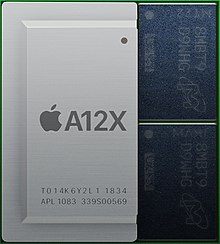Apple A12X
This article relies too much on references to primary sources. (December 2018) |
 | |
| General information | |
|---|---|
| Launched | October 30, 2018 |
| Discontinued | March 18, 2020 |
| Designed by | Apple Inc. |
| Common manufacturer(s) |
|
| Product code | APL1083[2] |
| Max. CPU clock rate | to 2.49[3] GHz |
| Cache | |
| L1 cache | 128 KB instruction, 128 KB data |
| L2 cache | 8 MB |
| Architecture and classification | |
| Application | Mobile |
| Technology node | 7 nm[4] |
| Microarchitecture | Vortex and Tempest |
| Instruction set | A64 – ARMv8.3-A |
| Physical specifications | |
| Cores |
|
| GPU(s) | Apple-designed 7-core[4] |
| Products, models, variants | |
| Variant(s) |
|
| History | |
| Predecessor | Apple A10X |
| Successor | Apple A12Z |
The Apple A12X Bionic is a 64-bit system on a chip (SoC) designed by Apple Inc. It first appeared in the iPad Pro (3rd generation), announced on October 30, 2018.[4] The A12X is an 8-core variant of the A12 (four big cores, four small cores) and Apple states that it has 35 percent faster single-core CPU performance and 90 percent faster overall CPU performance than its predecessor, the Apple A10X.[4] The A12X's design is also used in the Apple A12Z[5]and the Apple M1.
Design[]
The A12X features an Apple-designed 64-bit ARMv8.3-A octa-core CPU, with four high-performance cores called Vortex and four energy-efficient cores called Tempest.[4][1] The Vortex cores are a 7-wide decode out-of-order superscalar design, while the Tempest cores are a 3-wide decode out-of-order superscalar design. The Tempest cores are based on Apple's Swift cores from the Apple A6, and are similar in performance to ARM Cortex-A73 CPU cores.[6][7] It is Apple's first SoC with an octa core CPU.[1]
The A12X integrates an Apple-designed hepta core graphics processing unit (GPU) with twice the graphics performance of the A10X.[4] Embedded in the A12X is the M12 motion coprocessor.[8] The A12X includes dedicated neural network hardware that Apple calls a "Next-generation Neural Engine".[4] This neural network hardware, which is the same as found in the A12,[1] can perform up to 5 trillion operations per second.[4]
The A12X is manufactured by TSMC using a 7 nm FinFET process, and it contains 10 billion transistors[1][4] vs. the 6.9 billion on the A12.[9] The A12X is paired with 4 GB of LPDDR4X memory in the third-generation 12.9" iPad Pro and the 11" iPad Pro or 6 GB in the 1TB storage configurations.[10][2]
The support of Codecs by decoding and encoding is extended to HEVC 264, 265 (8/10bit), VP 8, VP9 and JPEG. AVC and VC1 are available for decoding. AV1 is not supported by hardware. [11]
Products that include the Apple A12X[]
See also[]
- Apple silicon, the range of ARM-based processors designed by Apple.
- Apple A12
- Apple A12Z
References[]
- ^ a b c d e f Frumusanu, Andrei (October 30, 2018). "Apple Announces New 11" and 12.9" iPad Pros with A12X SoC". AnandTech. Retrieved October 30, 2018.
- ^ a b "iPad Pro 11" Teardown". iFixit. November 12, 2018. Retrieved November 12, 2018.
- ^ "iPad8,8 - Geekbench Browser". Geekbench. Retrieved November 12, 2018.
- ^ a b c d e f g h i "New iPad Pro with all-screen design is most advanced, powerful iPad ever" (Press release). Apple Inc. October 30, 2018. Retrieved October 30, 2018.
- ^ "Looking at the Apple A12Z Bionic System on Chip | TechInsights".
- ^ Frumusanu, Andrei. "The iPhone XS & XS Max Review: Unveiling the Silicon Secrets". www.anandtech.com. Retrieved January 27, 2019.
- ^ Frumusanu, Andrei. "Apple iPhone XS Review Addendum: Small Core and NN Performance". www.anandtech.com. Retrieved May 1, 2019.
- ^ "iPad Pro Technical Specifications". Apple Inc. October 30, 2018. Archived from the original on October 30, 2018. Retrieved October 30, 2018.
- ^ Summers, Nick (September 12, 2018). "Apple's A12 Bionic is the first 7-nanometer smartphone chip". Engadget. Retrieved September 12, 2018.
- ^ Axon, Samuel (November 7, 2018). "2018 iPad Pro review: "What's a computer?"". Ars Technica. Condé Nast. Retrieved November 12, 2018.
- ^ "Apple A12".
- Apple Inc. mobile processors
- ARM architecture
- Computer-related introductions in 2018
